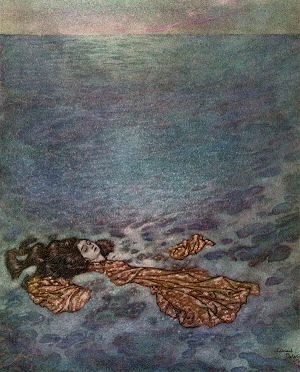|
Above: The Little Mermaid: Dissolving into Foam, Edmund Dulac, 1911 By Chris Fitzner Glorious red hair, green tail, an amazing singing voice; when you say ‘mermaid’ that is the mental image the average person would draw. When Disney’s Ariel makes her splash debut in season three of Once Upon A Time, there’s a good chance that will be what she looks like. But Ariel is only the tip of the iceberg as far as mermaids go. Mermaids have been a part of folklore traditions throughout the world for thousands of years. “Mermaid” is a compound of the Old English mere (sea) and maid (girl or young woman). The Old English equivalent being merewif. But the first stories of mermaids (or mere type creatures) make their appearance in ancient Assyria circa 1000 B.C.E. in the form of the goddess, Atargatis, who loved a human shepherd and after accidentally killing him, Atargatis leaped into the water in shame, transforming herself into a fish. The water was unable to hide her divine beauty and she took the form of a mermaid, human above the waist and a fish below the waist (similar to the Babylonian god, Ea). The ancient Greeks recognized Atargatis under the name Derketo. Though mermaids have long been associated with music, their voices having the ability to enthrall and lure sailors to their deaths, Andersen’s tale contains no singing crabs, annoying sea gulls or cowardly flounders. I certainly can’t blame the Walt Disney Company for wanting to jazz it up a bit; or a lot. In mermaid fandom, ‘mermaiding’ has grown in popularity alongside fantasy cosplay. Mermaiding is the practice of performing dolphin kicks and other movements underwater while bound in a costume mermaid tail. Mermaid performances, most famously done by the Weeki Wachee Springs Mermaid Show in Florida, began as roadside attractions and reached the height of their popularity in the mid-twentieth century. In Halifax, Nova Scotia, you can even hire a mermaid for your event. Raina the Halifax Mermaid entertains and educates on local ocean ecology issues. (http://rainamermaid.blogspot.ca/) The most famous story and the origins (if you will) to Ariel is “The Little Mermaid” by Hans Christian Andersen, published in 1837. It has always struck me as a sad tale, especially after the happier Disney version, as the little mermaid doesn’t get her happily ever after with the prince and even her life on land was a torment. Your tail will then disappear, and shrink up into what mankind calls legs, and you will feel great pain, as if a sword were passing through you. But all who see you will say that you are the prettiest little human being they ever saw. You will still have the same floating gracefulness of movement, and no dancer will ever tread so lightly; but at every step you take it will feel as if you were treading upon sharp knives, and that the blood must flow. “The Little Mermaid”, Hans Christian Andersen In the end, her beloved prince marries another and in order to return to her sisters in the sea, the mermaid must stab the prince through the heart. In the end, the little mermaid cannot kill the prince, for love of him and his bride and she flings herself overboard, appearing to become sea foam and turning into a daughter of the air. Mermaids do not have immortal souls and can only obtain one by marrying a human; by becoming a daughter of the air, the little mermaid could earn her way to a soul after three centuries. From ancient myth and folklore, mermaids have glided through the centuries, most often as unlucky omens, foretelling disaster and provoking it. Though they could occasionally be beneficent and benevolent, they were often dreaded signs to sailors and those in coastal cities. Sailors reported seeing mermaids, sometimes swimming alongside their vessels. In January 1493, Christopher Columbus reported seeing three mermaids swimming ahead of his ship off the coast of present day Dominican Republic. Traditionally depicted as beautiful with long flowing hair, Columbus said they weren’t half as beautiful as they were painted. In this case as with the others, it is believed that it was misidentification. Mermaid sightings (when not made up) were likely manatees, dugongs or Steller’s sea cows (extinct in the 1760s). Manatees and dugongs belong to the order Sirenia; fully aquatic, herbivorous mammals that inhabit rivers, estuaries, coastal marine waters and swamps. They look clumsy but are fusiform, hydrodynamic and highly muscular. They were often taken for mermaids and if I were at sea for as long as mariners before the twentieth century, anything might seem attractive after a while! Sadly, for those of us longing for real mermaids and despite sightings even in the twentieth and twenty first centuries, the U.S. National Ocean Service stated in 2012 that no evidence of mermaids has ever been found. That doesn’t stop the wild and fertile human imagination though and mermaids are firmly entrenched in it. From Melusine in Western Europe, rusalkas in Eastern Europe (though the rusalkas lacked a fish-like tail), mermaids and their water spirit counterparts haunt the waters of our past and present pop culture. With Ariel scant months away from our television screens, the directions that the writers of Once could go are as endless as the deep blue sea. Might we see an Ariel with some of the darker, more mischievous traits of old folklore or will she be more the bubbly red head of our childhood memories? We’ll have to wait until season three airs to find out.
0 Comments
Leave a Reply. |
OriginsExplore the Arthurian legend surrounding Lancelot, take a trip into the woods to discover the mythology behind Red Riding Hood or learn more about a modern day hero called Snow White. Origins provides unique insights and perspectives from talented writers into the characters we know and love, going far beyond the boundaries of Storybrooke. Archives
August 2016
Categories
All
|

